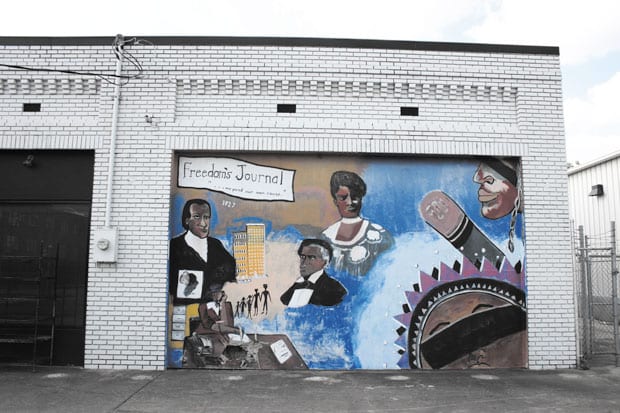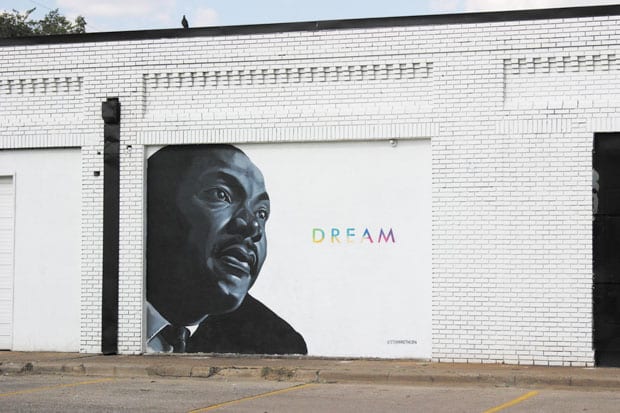A South Dallas neighborhood is emerging as one of the nation’s first black gayborhoods

JAMES RUSSELL | Staff Writer
A neighborhood in south Dallas bound by Fair Park, I-45 and I-30 is among the many neighborhoods in the historically blighted area beginning to garner real estate developers’ attention. Thanks to a push by civic and business leaders to provide affordable housing and more infrastructure investments such as transportation, the storefronts by Fair Park are slowly filling up.
The neighborhood is also on the verge of becoming one of the first African-American gayborhoods in the region, if not the country.
Historically, the Fair Park area has been one of the poorest in all of Dallas County. According to The Fair Park Neighborhood Study conducted by the University of Texas at Dallas, incomes in the area range from $8,600 to $35,000. The three-mile radius around the 2,000-acre Fair Park grounds is home to 26,000 residents, most of whom are African-American. But there is also a growing Hispanic population as well.
The recent infrastructure improvements, including expanded public transportation services like the bus and light rail, have spurred additional development and a renewed interest in the neighborhood.
Driving down Martin Luther King, Jr. Boulevard, you wouldn’t know the neighborhood is burgeoning. But Kirk Myers, chief executive officer of Abounding Prosperity, has seen the area develop. In fact, his organization’s office is at one of the gateways to the gayborhood, situated at the intersection of Martin Luther King Boulevard and Interstate 45.
 His vision is this: Martin Luther King, Jr. Boulevard could not only serve as a gateway to Fair Park — which he calls “the crown jewel of South Dallas” — but to an entire vibrant and creative neighborhood with residential and commercial appeal.
His vision is this: Martin Luther King, Jr. Boulevard could not only serve as a gateway to Fair Park — which he calls “the crown jewel of South Dallas” — but to an entire vibrant and creative neighborhood with residential and commercial appeal.
But before commercial activity there must be evidence of residential activity, Myers acknowledged. And commercial development may not even look like retail boutiques, but maybe general services instead.
For instance, the Dallas Black Chamber of Commerce and Martin Luther King Jr. Community Center are already located along the boulevard. And Myers said he has already seen development across from Fair Park, including new housing developments as well as salons and restaurants.
The main thoroughfare would be further from Fair Park itself, however, with the convergence at MLK Boulevard.
“If it happens, that’s where it’ll be,” Myers said. “We are seeing a movement where black gays in Dallas are moving into the neighborhood. It may be 10 people at its highest right now, but the neighborhood is becoming increasingly visible.”
At a recent block party ahead of the black Pride events, fairgoers didn’t seem to mind the exuberant partygoers across the street. It was late in the evening, but those attending a pre-Dallas black Pride event were contributing to the neighborhood. And no one seemed bothered by it.
“In a neighborhood you’d think was homophobic we were accepted,” Myers said. “We were creating a vibrant environment.”
Historically, the LGBT community has created thriving neighborhoods. Myers pointed to the gentrification of Cedar Springs in the 1980s and 1990s. The push to create a welcoming and safe space for LGBT people transformed a blighted area into what it is today — one of the nation’s most well known and frequented gayborhoods.
But now the high rent has pushed a lot of people to look elsewhere. If history is a guide, then where the gays go, so will more development.
“Gay history is [intertwined] with gentrification. We make neighborhoods beautiful,” Myers said.
 The goal, if the neighborhood emerges, is to create a neighborhood in which to live, work and play.
The goal, if the neighborhood emerges, is to create a neighborhood in which to live, work and play.
Several LGBT African-American residents have already moved in. A rainbow flag, sitting undisturbed first turned Myers’ attention to the phenomenon.
Buster Spiller lives near Bachman Lake in North Dallas, but most of his civic activities happen in South Dallas. He’s worked with the Martin Luther King Jr. Friends of the Library and doing HIV outreach with the Dallas Urban League among others. He even briefly lived in the neighborhood in the 1993.
“That was a while back!” Spiller said. He agrees with Myers that a gayborhood could certainly emerge. But, he added, “it’s always been there, but just a lot more quiet.
“The social climate is just changing. A transgender person could go into Wal-Mart without it being a big deal,” Spiller added. “People are just freer and everything’s a lot more open.”
The neighborhood’s development is long overdue, which may explain why there hasn’t been pushback by the neighborhood. The fact that there is a real disparity between North Dallas and South Dallas may also create a more welcoming climate.
“Typically the southern sector of Dallas has gotten the short end of the stick even though the largest chunk of the city’s population lives in South Dallas,” Spiller said.
Now that apartments and newer single-family homes have popped up, Spiller gets why more African-American LGBT citizens would re-consider the Fair Park area.
“As it’s revamped, it’s the people who are going to contribute to the betterment of South Dallas,” he said.
This article appeared in the Dallas Voice print edition October 2, 2015.











